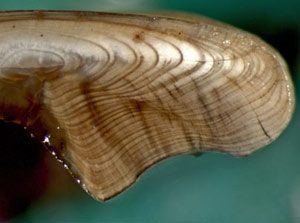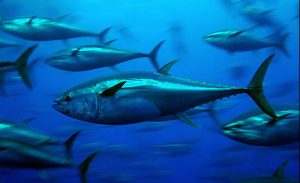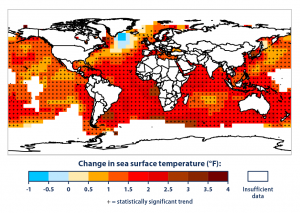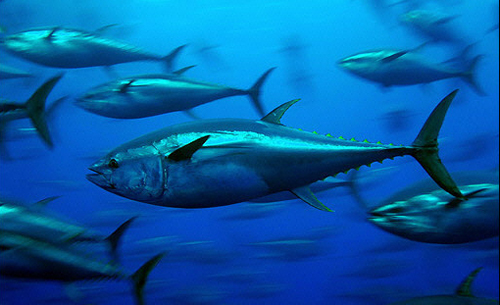Climate Change as Seen Through Atlantic Bluefin Tuna
By Olivia Schuitema, SRC intern
Climate change is the phenomenon in which global temperatures are rising due to an increase in the amount of CO2 in the atmosphere, largely resulting from burning fossil fuels and deforestation. The Earth’s ozone layer acts as a protective “blanket,” trapping warming greenhouse gases, such as CO2, in the Earth’s atmosphere. This “greenhouse effect” also affects the oceans; in the last 45 years, the mean ocean temperature in the upper 300m (where a majority of marine life live) has increased by 0.3°C (Muhling, 2011). Although this change seems small, even minor differences in temperature, salinity, and pH can affect organism and ecosystem success.
As atmospheric CO2 concentration increases, more CO2 dissolves into seawater and results in decreasing amounts of inorganic carbon in the ocean (Fraile, 2016). The inorganic carbon isotope is an important element in recycling nutrients throughout the ocean. Similarly, the ratio of stable oxygen isotopes in seawater can be related to the temperature and salinity of the water (Fraile, 2016), which can affect marine habitats. A recent study aiming to estimate CO2 uptake in the Mediterranean Sea over the past 20 years, suggests that evidence of climate change, spurring changes in the ratios of stable carbon and oxygen isotopes, can be seen in Atlantic bluefin tuna, Thunnus thynnus, otoliths. Otoliths are aragonite structures located in the inner ear of teleost fish that aid in balance and orientation (Fraile, 2016). As bluefin tuna age, they add new layers of aragonite on their otoliths, forming rings. The otolith layers are used similarly to ice cores and tree rings, in which they show environmental conditions, such as the amount of CO2, of the time period. In their first year of life, tuna are highly mobile and remain in surface waters of the Mediterranean Basin. Thus, the carbon and oxygen isotopes accumulated in the first year of life, shown in the central otolith layer (“otolith core”), are likely to reflect the seawater conditions of the Mediterranean Basin (Fraile, 2016).

Figure 1. The rings in fish otoliths can be used to determine fish age, NOAA
Researchers captured tuna of different sizes and measured their fork lengths (from the tip of the snout to the fork of caudal fin) in order to help determine their age. Otoliths were extracted from the tuna and cut in a cross-section to expose the otolith core (Fraile, 2016). Cores were powdered and analyzed for stable carbon and oxygen isotopes. Combining the anatomical age data and the otolith core data, a record of the annual amount of carbon and oxygen isotopes was compiled for the years 1989-2010. It was found that oceanic carbon and oxygen decreased in the studied years, inversely related to increasing atmospheric CO2 (Fraile, 2016). Decreasing amounts of inorganic carbon have negative impacts on biogeochemical cycling (cycling of nutrients, such as carbon, between the sediment, organisms and the water) in the ocean, leading to changes in environmental conditions. These changes could have cascading effects, affecting species on the organismal level and affecting populations throughout entire food chains.

Figure 2. Atlantic Bluefin Tuna, Thunnus thynnus, NOAA
Climate change can also lead to increasing ocean temperatures, which puts stress on marine organisms and causes degradation of marine habitats. Many fish, such as the Atlantic bluefin tuna, undergo physiological stress due to increase in seawater temperature, which impacts swimming abilities, spawning activities, egg hatching and larval growth (Muhling, 2015). A study conducted in the Gulf of Mexico and the Caribbean Sea aimed to gain further insight on the effects of climate change on tuna species through modeling systems (Muhling, 2015). Researchers applied ocean temperature fields with past and present data onto models of suitability (optimal conditions for survival) for the larval and adult stages of skipjack tuna and Atlantic bluefin tuna.
It was found that Atlantic bluefin tuna larva and adult survival decreased with increasing surface temperature (warmest temperatures in water column) and increased at deeper depths with cooler water (Muhling, 2015). This suggests that the temperate Atlantic bluefin tuna prefer to inhabit cooler waters and are negatively affected by warming temperatures. Conversely, tropical skipjack tuna larva and adults had higher survival rates at higher surface temperatures, indicating a preference for warmer temperatures. Future projections were also made, by using current tuna habitat suitability models with projected environmental trends due to climate change. By 2090, waters in the Gulf of Mexico will be highly unsuitable for both adult and larval stages of Atlantic bluefin tuna (Muhling, 2015). On the other hand, skipjack tuna adult and larvae suitability is projected to expand greatly, and possibly expand into bluefin tuna habitat in the future. As seen in this study, climate change can cause unbalanced changes in top predator ocean dynamics; some species like the skipjack tuna, thrive and have the potential to over dominate, while others, like the Atlantic bluefin tuna, are negatively impacted and can have a potentially reduced role in food webs.

Figure 3. Change in sea surface temperature 1901-2015, EPA
Global climatic patterns are also influenced by climate change. With increasing temperatures, there has been an increase in the frequency of droughts and heat waves (ex. California), and similarly, an increase in the number and intensity of hurricanes and tropical storms in the Caribbean (ex. Hurricanes Irma and Maria in 2017). According to a study conducted by analyzing Atlantic bluefin tuna vertical migrations with seasonal environmental conditions, tuna behavior is affected by ocean surface temperature (Bauer, 2017). During average seasonal temperatures, common bluefin tuna behavior involves periods of surfacing. However, data shows unusual deep diving intervals during thermal fronts, due to the increase in water surface temperature (Bauer, 2017). Researchers hypothesize that increasing numbers of abnormal climate events can greatly affect the behavior of vertical migrators, such as sharks, sailfish and the Atlantic bluefin tuna (Bauer, 2017).
Rising global temperatures, largely due to anthropogenic influences, can cause a wide array of changes in the earth’s climate including extreme weather events, ocean acidification, and sea level rise. Systems in the marine environment, along with commercial and recreational fisheries, will also be adversely affected (Muhling, 2011). The effects of climate change will continue to intensify unless measures are taken to reduce the anthropogenic footprint on the earth.
References
Bauer, Fromentin, Demarcq, & Bonhommeau. (2017). Habitat use, vertical and horizontal behaviour of Atlantic bluefin tuna (Thunnus thynnus) in the Northwestern Mediterranean Sea in relation to oceanographic conditions. Deep-Sea Research Part II, 141, 248-261.
Fraile, Arrizabalaga, Groeneveld, Kölling, Santos, Macías, . . . Rooker. (2016). The imprint of anthropogenic CO2 emissions on Atlantic bluefin tuna otoliths. Journal of Marine Systems, 158, 26-33.
Muhling, Liu, Lee, Lamkin, Roffer, Muller-Karger, & Walter. (2015). Potential impact of climate change on the Intra-Americas Sea: Part 2. Implications for Atlantic bluefin tuna and skipjack tuna adult and larval habitats. Journal of Marine Systems, 148, 1-13.
Muhling, B. A., Lee, S. K., Liu, Y. T., & Lamkin, J. (2011). Predicting the effects of climate change on bluefin tuna (Thunnus thynnus) spawning habitat in the Gulf of Mexico. ICES Journal of Marine Science, 68(6), 1051-1062.




Leave a Reply
Want to join the discussion?Feel free to contribute!